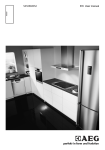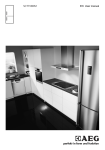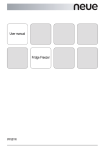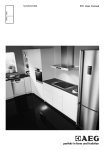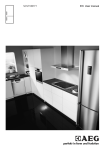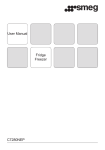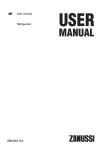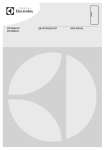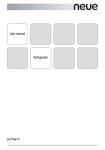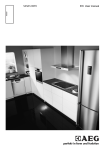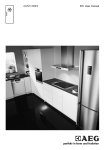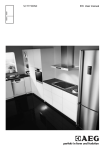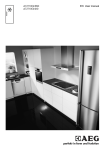Download SCS51800F1 EN User manual
Transcript
SCS51800F1 EN User manual 2 www.aeg.com CONTENTS 1. 2. 3. 4. 5. 6. 7. 8. 9. SAFETY INSTRUCTIONS . . . . . . . . . . . . . . . . . . . . . . . . . . . . . . . . . . . . . . . . . . . . . . . . . . . . . . 3 OPERATION . . . . . . . . . . . . . . . . . . . . . . . . . . . . . . . . . . . . . . . . . . . . . . . . . . . . . . . . . . . . . . . . 5 DAILY USE . . . . . . . . . . . . . . . . . . . . . . . . . . . . . . . . . . . . . . . . . . . . . . . . . . . . . . . . . . . . . . . . . 6 HELPFUL HINTS AND TIPS . . . . . . . . . . . . . . . . . . . . . . . . . . . . . . . . . . . . . . . . . . . . . . . . . . . . 8 CARE AND CLEANING . . . . . . . . . . . . . . . . . . . . . . . . . . . . . . . . . . . . . . . . . . . . . . . . . . . . . . . 9 WHAT TO DO IF… . . . . . . . . . . . . . . . . . . . . . . . . . . . . . . . . . . . . . . . . . . . . . . . . . . . . . . . . . 11 INSTALLATION . . . . . . . . . . . . . . . . . . . . . . . . . . . . . . . . . . . . . . . . . . . . . . . . . . . . . . . . . . . . 12 NOISES . . . . . . . . . . . . . . . . . . . . . . . . . . . . . . . . . . . . . . . . . . . . . . . . . . . . . . . . . . . . . . . . . . . 13 TECHNICAL DATA . . . . . . . . . . . . . . . . . . . . . . . . . . . . . . . . . . . . . . . . . . . . . . . . . . . . . . . . . . 15 FOR PERFECT RESULTS Thank you for choosing this AEG product. We have created it to give you impeccable performance for many years, with innovative technologies that help make life simpler – features you might not find on ordinary appliances. Please spend a few minutes reading to get the very best from it. Visit our website for: Get usage advice, brochures, trouble shooter, service information: www.aeg.com Register your product for better service: www.aeg.com/productregistration Buy Accessories, Consumables and Original spare parts for your appliance: www.aeg.com/shop CUSTOMER CARE AND SERVICE We recommend the use of original spare parts. When contacting Service, ensure that you have the following data available. The information can be found on the rating plate. Model, PNC, Serial Number. Warning / Caution-Safety information General information and tips Environmental information Subject to change without notice. ENGLISH 1. 3 SAFETY INSTRUCTIONS In the interest of your safety and to ensure the correct use, before installing and first using the appliance, read this user manual carefully, including its hints and warnings. To avoid unnecessary mistakes and accidents, it is important to ensure that all people using the appliance are thoroughly familiar with its operation and safety features. Save these instructions and make sure that they remain with the appliance if it is moved or sold, so that everyone using it through its life will be properly informed on appliance use and safety. For the safety of life and property keep the precautions of these user's instructions as the manufacturer is not responsible for damages caused by omission. 1.1 Children and vulnerable people safety • This appliance is not intended for use by persons (including children) with reduced physical, sensory or mental capabilities, or lack of experience and knowledge, unless they have been given supervision or instruction concerning use of the appliance by a person responsible for their safety. Children should be supervised to ensure that they do not play with the appliance. • Keep all packaging well away from children. There is risk of suffocation. • If you are discarding the appliance pull the plug out of the socket, cut the connection cable (as close to the appliance as you can) and remove the door to prevent playing children to suffer electric shock or to close themselves into it. • If this appliance featuring magnetic door seals is to replace an older appliance having a spring lock (latch) on the door or lid, be sure to make that spring lock unusable before you discard the old appliance. This will prevent it from becoming a death trap for a child. 1.2 General safety WARNING! Keep ventilation openings, in the appliance enclosure or in the built-in structure, clear of obstruction. • The appliance is intended for keeping foodstuff and/or beverages in a normal household and similar applications such as: – staff kitchen areas in shops, offices and other working environments; – farm houses and by clients in hotels, motels and other residential type environments; – bed and breakfast type environments; – catering and similar non-retail applications. • Do not use a mechanical device or any artificial means to speed up the thawing process. • Do not use other electrical appliances (such as ice cream makers) inside of refrigerating appliances, unless they are approved for this purpose by the manufacturer. • Do not damage the refrigerant circuit. • The refrigerant isobutane (R600a) is contained within the refrigerant circuit of the appliance, a natural gas with a high level of environmental compatibility, which is nevertheless flammable. During transportation and installation of the appliance, be certain that none of the components of the refrigerant circuit become damaged. If the refrigerant circuit should become damaged: – avoid open flames and sources of ignition – thoroughly ventilate the room in which the appliance is situated • It is dangerous to alter the specifications or modify this product in any way. Any damage to the cord may cause a short-circuit, fire and/or electric shock. 4 www.aeg.com WARNING! Any electrical component (power cord, plug, compressor) must be replaced by a certified service agent or qualified service personnel to avoid hazard. 1. • • • • Power cord must not be lengthened. 2. Make sure that the power plug is not squashed or damaged by the back of the appliance. A squashed or damaged power plug may overheat and cause a fire. 3. Make sure that you can come to the mains plug of the appliance. 4. Do not pull the mains cable. 5. If the power plug socket is loose, do not insert the power plug. There is a risk of electric shock or fire. 6. You must not operate the appliance without the lamp cover (if foreseen) of interior lighting. This appliance is heavy. Care should be taken when moving it. Do not remove nor touch items from the freezer compartment if your hands are damp/wet, as this could cause skin abrasions or frost/freezer burns. Avoid prolonged exposure of the appliance to direct sunlight. Bulb lamps (if foreseen) used in this appliance are special purpose lamps selected for household appliances use only. They are not suitable for household room illumination. 1.3 Daily Use • Do not put hot pot on the plastic parts in the appliance. • Do not store flammable gas and liquid in the appliance, because they may explode. • Do not place food products directly against the air outlet on the rear wall. (If the appliance is Frost Free) • Frozen food must not be re-frozen once it has been thawed out. • Store pre-packed frozen food in accordance with the frozen food manufacturer's instructions. • Appliance's manufacturers storage recommendations should be strictly adhered to. Refer to relevant instructions. • Do not place carbonated or fizzy drinks in the freezer compartment as it creates pressure on the container, which may cause it to explode, resulting in damage to the appliance. • Ice lollies can cause frost burns if consumed straight from the appliance. 1.4 Care and cleaning • Before maintenance, switch off the appliance and disconnect the mains plug from the mains socket. • Do not clean the appliance with metal objects. • Do not use sharp objects to remove frost from the appliance. Use a plastic scraper. • Regularly examine the drain in the refrigerator for defrosted water. If necessary, clean the drain. If the drain is blocked, water will collect in the bottom of the appliance. 1.5 Installation For electrical connection carefully follow the instructions given in specific paragraphs. • Unpack the appliance and check if there are damages on it. Do not connect the appliance if it is damaged. Report possible damages immediately to the place you bought it. In that case retain packing. • It is advisable to wait at least four hours before connecting the appliance to allow the oil to flow back in the compressor. • Adequate air circulation should be around the appliance, lacking this leads to overheating. To achieve sufficient ventilation follow the instructions relevant to installation. • Wherever possible the back of the product should be against a wall to avoid touching or catching warm parts (compressor, condenser) to prevent possible burn. ENGLISH • The appliance must not be located close to radiators or cookers. • Make sure that the mains plug is accessible after the installation of the appliance. • Connect to potable water supply only (If a water connection is foreseen). 1.6 Service • Any electrical work required to do the servicing of the appliance should be carried out by a qualified electrician or competent person. • This product must be serviced by an authorized Service Centre, and only genuine spare parts must be used. 5 ozone layer, in either its refrigerant circuit or insulation materials. The appliance shall not be discarded together with the urban refuse and rubbish. The insulation foam contains flammable gases: the appliance shall be disposed according to the applicable regulations to obtain from your local authorities. Avoid damaging the cooling unit, especially at the rear near the heat exchanger. The materials used on this appliance marked by the are recyclable. symbol 1.7 Environment Protection This appliance does not contain gasses which could damage the 2. OPERATION 1 2 4 1 Temperature indicator LED 2 FROSTMATIC indicator 3 FROSTMATIC button 4 Temperature regulator ON/OFF button 2.1 Switching on Insert the plug into the wall socket. Touch the temperature regulator button if all LED are off. 3 2.2 Switching off Keep touching the temperature regulator button for 3 Sec. All indicators light off. 2.3 Temperature regulation To operate the appliance, proceed as follows: • touch the temperature regulator button until the LED corresponding to the required temperature lights up. Selec- 6 www.aeg.com tion is progressive, varying from 2 to 8°C. At first button touch actual setting LED keeps blinking. Any time the button is touch the set temperature is moved to 1 position right. Corresponding LED will blink for a while. Touch the setting button until the required temperature is selected. The set will be fixed coldest setting: +2°C warmest setting: +8°C A medium setting is generally the most suitable. However, the exact setting should be chosen keeping in mind that the temperature inside the appliance depends on: • room temperature • how often the door is opened • quantity of food stored • appliance location. 2.4 FROSTMATIC function You can activate theFROSTMATIC function by pressing theFROSTMATIC button. The LED corresponding to the symbol FROSTMATICindicator lights up. You can deactivate theFROSTMATIC function by pressing the FROSTMATIC button again. The FROSTMATIC indicator will light off. This function stops automatically after 52 hours. 3. DAILY USE 3.1 Cleaning the interior Before using the appliance for the first time, wash the interior and all internal accessories with lukewarm water and some neutral soap so as to remove the typical smell of a brand-new product, then dry thoroughly. Do not use detergents or abrasive powders, as these will damage the finish. 3.2 Freezing fresh food The freezer compartment is suitable for freezing fresh food and storing frozen and deep-frozen food for a long time. To freeze fresh foods it is not necessary to change the medium setting. However, for a faster freezing operation, turn the temperature regulator toward higher settings to obtain the maximum coldness. In this condition, the refrigerator compartment temperature might drop below 0°C. If this occurs reset the temperature regulator to a warmer setting. Place the fresh food to be frozen on the top compartment. 3.3 Storage of frozen food When first starting-up or after a period out of use, before putting the products in the compartment let the appliance run at least 2 hours on the higher settings. If large quantities of food are to be stored, remove all drawers and baskets from appliance and place food on cooling shelves to obtain the best performance. WARNING! Make sure that foods do not exceed the load limit stated on the side of the upper section (where applicable) In the event of accidental defrosting, for example due to a power failure, if the power has been off for longer that the value shown in the technical characteristics chart under "rising time", the defrosted food must be consumed quickly or cooked immediately and then re-frozen (after cooling). ENGLISH 3.4 Thawing Deep-frozen or frozen food, prior to being used, can be thawed in the refrigerator compartment or at room temperature, depending on the time available for this operation. Small pieces may even be cooked still frozen, directly from the freezer: in this case, cooking will take longer. 7 cubes. Fill these trays with water, then put them in the freezer compartment. Do not use metallic instruments to remove the trays from the freezer. 3.5 Ice-cube production This appliance is equipped with one or more trays for the production of ice- 3.6 Movable shelves The walls of the refrigerator are equipped with a series of supports so that the shelves can be positioned as desired. 3.7 Positioning the door shelves To permit storage of food packages of various sizes, the door shelves can be placed at different heights. 3.8 Positioning the sliding box The sliding box can be placed at different heights. Do make these adjustments proceed as follow: 1. lift the shelf with the sliding box upwards and out of the holders in the door 2. remove the retaining bracket out of the guide under the shelf 3. Reverse the above operation to insert the sliding box at a different height. 8 www.aeg.com 4. HELPFUL HINTS AND TIPS 4.1 Hints for energy saving • Do not open the door frequently or leave it open longer than absolutely necessary. • If the ambient temperature is high and the Temperature Regulator is set to low temperature and the appliance is fully loaded, the compressor may run continuously, causing frost or ice on the evaporator. If this happens, set the Temperature Regulator toward warmer settings to allow automatic defrosting and so a saving in electricity consumption. 4.2 Hints for fresh food refrigeration To obtain the best performance: • do not store warm food or evaporating liquids in the refrigerator • do cover or wrap the food, particularly if it has a strong flavour • position food so that air can circulate freely around it 4.3 Hints for refrigeration Useful hints: Meat (all types) : wrap in polythene bags and place on the glass shelf above the vegetable drawer. For safety, store in this way only one or two days at the most. Cooked foods, cold dishes, etc.: these should be covered and may be placed on any shelf. Fruits and vegetables: these should be thoroughly cleaned and placed in the special drawer(s) provided. When in contact, lemon juice can discolor the plastic parts of your fridge. It is therefore recommended to keep citruses in separate containers. Butter and cheese: these should be placed in special airtight containers or wrapped in aluminium foil or polythene bags to exclude as much air as possible. Bottles: these should have a cap and should be stored in the bottle rack on the door. Bananas, potatoes, onions and garlic, if not packed, must not be kept in the refrigerator. 4.4 Hints for freezing To help you make the most of the freezing process, here are some important hints: • the maximum quantity of food which can be frozen in 24 hrs. is shown on the rating plate; • the freezing process takes 24 hours. No further food to be frozen should be added during this period; • only freeze top quality, fresh and thoroughly cleaned, foodstuffs; • prepare food in small portions to enable it to be rapidly and completely frozen and to make it possible subsequently to thaw only the quantity required; • wrap up the food in aluminium foil or polythene and make sure that the packages are airtight; • do not allow fresh, unfrozen food to touch food which is already frozen, thus avoiding a rise in temperature of the latter; • lean foods store better and longer than fatty ones; salt reduces the storage life of food; • water ices, if consumed immediately after removal from the freezer compartment, can possibly cause the skin to be freeze burnt; • it is advisable to show the freezing in date on each individual pack to enable you to keep tab of the storage time. 4.5 Hints for storage of frozen food To obtain the best performance from this appliance, you should: • make sure that the commercially frozen foodstuffs were adequately stored by the retailer; • be sure that frozen foodstuffs are transferred from the foodstore to the freezer in the shortest possible time; ENGLISH • not open the door frequently or leave it open longer than absolutely necessary; • once defrosted, food deteriorates rapidly and cannot be refrozen; 9 • do not exceed the storage period indicated by the food manufacturer. 5. CARE AND CLEANING CAUTION! Unplug the appliance before carrying out any maintenance operation. This appliance contains hydrocarbons in its cooling unit; maintenance and recharging must therefore only be carried out by authorized technicians. 5.1 Periodic cleaning The equipment has to be cleaned regularly: • clean the inside and accessories with lukewarm water and some neutral soap. • regularly check the door seals and wipe clean to ensure they are clean and free from debris. • rinse and dry thoroughly. Do not pull, move or damage any pipes and/or cables inside the cabinet. Never use detergents, abrasive powders, highly perfumed cleaning products or wax polishes to clean the interior as this will damage the surface and leave a strong odour. Clean the condenser (black grill) and the compressor at the back of the appliance with a brush. This operation will improve the performance of the appliance and save electricity consumption. Take care of not to damage the cooling system. Many proprietary kitchen surface cleaners contain chemicals that can attack/ damage the plastics used in this appliance. For this reason it is recommended that the outer casing of this appliance is only cleaned with warm water with a little washing-up liquid added. After cleaning, reconnect the equipment to the mains supply. 10 www.aeg.com 5.2 Defrosting the refrigerator Frost is automatically eliminated from the evaporator of the refrigerator compartment every time the motor compressor stops, during normal use. The defrost water drains out through a drain hole into a special container at the back of the appliance, over the motor compressor, where it evaporates. It is important to periodically clean the defrost water drain hole in the middle of the refrigerator compartment channel to prevent the water overflowing and dripping onto the food inside. 5.3 Defrosting the freezer A certain amount of frost will always form on the freezer shelves and around the top compartment. Defrost the freezer when the frost layer reaches a thickness of about 3-5 mm. About 12 hours prior to defrosting, set the Temperature regulator toward higher settings , in order to build up sufficient chill reserve for the interruption in operation. To remove the frost, follow the instructions below: 1. Switch off the appliance. 2. Remove any stored food, wrap it in several layers of newspaper and put it in a cool place. CAUTION! Do not touch frozen goods with wet hands. Hands can freeze to the goods. 3. Leave the door open. In order to speed up the defrosting process, place a pot of warm water in the freezer compartment. In addition, remove pieces of ice that break away before defrosting is complete. 4. When defrosting is completed, dry the interior thoroughly. 5. 6. Switch on the appliance. After two or three hours, reload the previously removed food into the compartment. Never use sharp metal tools to scrape off frost from the innerliner as you could damage it. Do not use a mechanical device or any artificial means to speed up the thawing process other than those recommended by the manufacturer. A temperature rise of the frozen food packs, during defrosting, may shorten their safe storage life. 5.4 Periods of non-operation When the appliance is not in use for long periods, take the following precautions: • disconnect the appliance from electricity supply • remove all food • defrost (if foreseen) and clean the appliance and all accessories • leave the door/doors ajar to prevent unpleasant smells. If the cabinet will be kept on, ask somebody to check it once in a while to prevent the food inside from spoiling in case of a power failure. ENGLISH 11 6. WHAT TO DO IF… CAUTION! Before troubleshooting, disconnect the power supply. Only a qualified electrician or competent person must do the troubleshooting that is not in this manual. There are some sounds during normal use (compressor, refrigerant circulation). Problem Possible cause Solution The appliance is noisy. The appliance is not installed properly. Check if the appliance stands stable (all the feet should be on the floor). The appliance does not operate. The plug is not connected to the mains socket correctly. Connect the plug to the mains socket correctly. The appliance is switched Switch on the appliance. off. The appliance has no power. There is no voltage in the mains socket. Connect a different electrical appliance to the mains socket. Contact a qualified electrician. The light device is in stand-by. Close and open the door. The unit is defective. Refer to "Replacing the control unit". The temperature is not set correctly. Set a higher temperature. The door is not closed correctly. Refer to "Closing the door". The door has been opened too frequently. Do not keep the door open longer than necessary. The food temperature is too high. Let the food temperature decrease to room temperature before storage. The room temperature is too high. Decrease the room temperature. Water flows on the rear plate of the refrigerator. During the automatic defrosting process, frost defrosts on the rear plate. This is correct. Water flows into the refrigerator. The water outlet is clogged. Clean the water outlet. The light device does not work. The compressor operates continually. Products prevent that wa- Make sure that products ter flows into the water do not touch the rear collector. plate. 12 www.aeg.com Problem Possible cause Solution The temperature in the appliance is too low/high. The temperature regulator is not set correctly. Set a higher/lower temperature. If your appliance is still not working properly after making the above checks, please contact the After Sales Centre. 6.1 Replacing the control unit The appliance is equipped with a longlife LED interior light. Only service is allowed to replace the control unit. Contact your Service Center. 6.2 Closing the door Clean the door gaskets. If necessary, adjust the door. Refer to "Installation". 3. If necessary, replace the defective door gaskets. Contact the Service Center. 1. 2. 7. INSTALLATION WARNING! This appliance must be earthed. The manufacturer declines any liability should these safety measures not be observed. 7.1 Positioning WARNING! If you are discarding an old appliance that has a lock or catch on the door, you must ensure that it is made unusable to prevent young children being trapped inside. A B The appliance shall have the plug accessible after installation. Install this appliance at a location where the ambient temperature corresponds to the climate class indicated on the rating plate of the appliance: Climate class Ambient temperature SN +10°C to + 32°C N +16°C to + 32°C ST +16°C to + 38°C T +16°C to + 43°C 7.2 Electrical Connection CAUTION! Any electrical work required to install this appliance should be carried out by a qualified electrician or competent person. C E D The wires in the mains lead are coloured in accordance with the following code: A Green and Yellow: Earth C Brown: Live E Blue: Neutral ENGLISH As the colours of the wires in the mains lead of this appliance may not correspond with the coloured markings identifying the terminals in your plug, proceed as follows: 1. Connect the wire coloured green and yellow to the terminal marked either with the letter “E“ or by the or coloured green earth symbol and yellow. 2. Connect the wire coloured blue to the terminal either marked with the letter “N“ or coloured black. 3. Connect the wire coloured brown to the terminal either marked with the “L“ or coloured red. 4. Check that no cut, or stray strands of wire is present and the cord clamp D is secure over the outer sheath. 5. Make sure the electricity supply voltage is the same as that indicated on the appliance rating plate. 6. Switch on the appliance. The appliance is supplied with a 13 amp plug fitted B. In the event of having to change the fuse in the plug supplied, a 13 amp ASTA approved (BS 1362) fuse must be used. WARNING! A cut off plug inserted into a 13 amp socket is a serious safety (shock) hazard. Ensure that it is disposed of safely. 7.3 Ventilation requirements 5 cm The airflow behind the appliance must be sufficient. min. 200 cm2 min. 200 cm2 8. NOISES There are some sounds during normal running (compressor, refrigerant circulation). 13 14 www.aeg.com SSS RRR ! HISSS! OK BL SSSRRR! HISSS! BLUBB! SSSRRR! HISSS! BLUBB! UB B! CLICK! BRRR! CRACK! IC CL K! BRRR! CR AC K! CLICK! BRRR! CRACK! ENGLISH 9. TECHNICAL DATA Dimension of the recess Height 1780 mm Width 560 mm Depth 550 mm Rising Time 24 h Voltage 230-240 V Frequency 50 Hz The technical information are situated in the rating plate on the internal left side of the appliance and in the energy label. 10. ENVIRONMENT CONCERNS Recycle the materials with the symbol . Put the packaging in applicable containers to recycle it. Help protect the environment and human health and to recycle waste of electrical and electronic appliances. Do not dispose appliances marked with the symbol with the household waste. Return the product to your local recycling facility or contact your municipal office. 15 222369508-A-412013 www.aeg.com/shop

















